| "Descrizione" by Street82 (2970 pt) | 2023-Apr-10 15:15 |
Review Consensus: 10 Rating: 10 Number of users: 1
| Evaluation | N. Experts | Evaluation | N. Experts |
|---|---|---|---|
| 1 | 6 | ||
| 2 | 7 | ||
| 3 | 8 | ||
| 4 | 9 | ||
| 5 | 10 |
E284 (Boric acid) is a naturally occurring inorganic acid that plays a direct role in calcium metabolism in mammals and is considered a vital micronutrient, however toxic at high concentrations in animals. It is hydrogen borate, a weak boron acid.
It was originally registered in the USA as a household insecticide and is still an effective and commonly used product to control a wide range of pests in public health, agricultural, and structural settings.
It appears in the form of a white powder consisting of colourless water-soluble crystals or an odourless white amorphous powder.
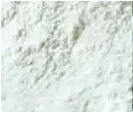
What it is used for and where
Medical
It has anti-inflammatory and antioxidant properties that have made it useful in various therapies.
It has been used for decades to treat yeast vaginitis, bacterial vaginosis, recurrent vulvovaginal candidiasis, and the additional use of boric acid in non-surgical periodontal therapy has been shown to be effective in treatment at 3 and 6 months (1).
Other studies have demonstrated the efficacy of boric acid against drug-resistant Candida albicans and Candida glabrata (2).
In ophthalmology it is used as an excipient in eye drops and as a multipurpose solution for tamponaded contact lenses as a disinfectant and without cytotoxic effects (3).
Food
Ingredient listed in the European food additives list as E284, preservative.
The Panel on Food Additives evaluated the safety of boric acid (E 284) and sodium tetraborate (borax) (E 285) as food additives in the EU. These additives are authorised in the EU for use as preservatives in sturgeon eggs (caviar) up to a maximum concentration of 4 g boric acid/kg. An ADI of 0.16 mg boron/kg body weight/day was established. The Panel concluded that boric acid and sodium tetraborate are not of concern in terms of genotoxicity (4)
Cosmetics
It is a restricted ingredient II/1395 as Relevant Item in the Annexes of the European Cosmetics Regulation No. 2019/831 (5).
Antimicrobial agent. This ingredient is able to suppress or inhibit the growth and replication of a broad spectrum of microorganisms such as bacteria, fungi and viruses by making the stratum corneum temporarily bactericidal and fungicidal.
Buffering agent. It is an iingredient that can bring an alkaline or acid solution to a certain pH level and prevent it from changing, in practice a pH stabiliser that can effectively resist instability and pH change.
Denaturant. The ionic or polar molecules of this ingredient included in formulations that interact with protein groups, modulate the properties of the solution to suit specific needs.
Other uses
Boric acid is widely used by the glass industry, particularly for glass fibres, in ceramics to improve strength and lustre. It is also used in metal welding, electronics, precious stones and scientific research.
For more information:
Typical commercial product characteristics Boric acid
| Appearance | White powder |
| Boiling Point | 219-220 °C (9.7513 mmHg) |
| Density | 1.4±0.1 g/cm3 |
| PSA | 60.69000 |
| Vapor Pressure | 2.6 mm Hg ( 20 °C) |
| LogP | -0.29 |
| Refraction Index | 1.385 |
| Water Solubility | 49.5 g/L (20 ºC) |
| Sulfate | ≤0.003 |
| B2O3 | ≥56 |
| Cl | ≤0.0005% |
| Fe | ≤0.0004% |
| B | ≥17% |
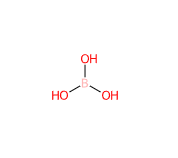 | 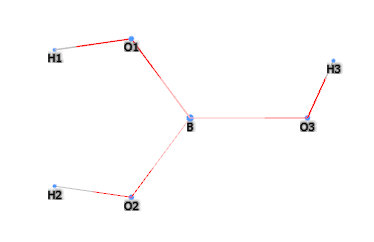 |
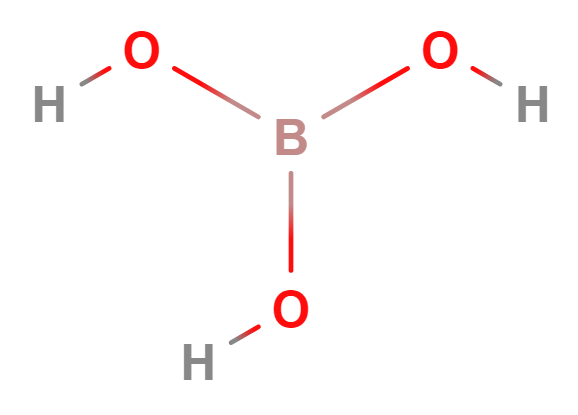 | 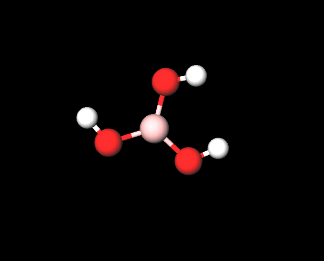 |
- Molecular Formula H3BO3 B(OH)3 BH3O3
- Molecular Weight 61.84
- Exact Mass 62.017525
- CAS 10043-35-3
- UNII R57ZHV85D4
- EC Number 233-139-2
- DSSTox Substance ID DTXSID1020194
- IUPAC boric acid
- InChI=1S/BH3O3/c2-1(3)4/h2-4H
- InChl Key KGBXLFKZBHKPEV-UHFFFAOYSA-N
- SMILES B(O)(O)O
- MDL number MFCD00011337
- PubChem Substance ID 329773111
- ChEBI 33118
- NCI C47416
- ICSC 0991
- RXCUI 1700
- RTECS ED4550000
- eCl@ss 38120104
- NACRES NA.21
Price 500g €42,80
Synonyms
- Orthoboric acid
- Boracic acid
- Trihydroxyborone
- Boron hydroxide
References________________________________________________________________________
(1) Bashir NZ, Krstic M. Boric acid as an adjunct to periodontal therapy: A systematic review and meta-analysis. Int J Dent Hyg. 2021 May;19(2):139-152. doi: 10.1111/idh.12487.
(2) Larsen B, Petrovic M, De Seta F. Boric Acid and Commercial Organoboron Products as Inhibitors of Drug-Resistant Candida albicans. Mycopathologia. 2018 Apr;183(2):349-357. doi: 10.1007/s11046-017-0209-6.
(3) Lehmann DM, Cavet ME, Richardson ME. Nonclinical safety evaluation of boric acid and a novel borate-buffered contact lens multi-purpose solution, Biotrue™ multi-purpose solution. Cont Lens Anterior Eye. 2010 Dec;33 Suppl 1:S24-32. doi: 10.1016/j.clae.2010.06.010.
Kikuchi T, Suzuki M, Kusai A, Iseki K, Sasaki H. Synergistic effect of EDTA and boric acid on corneal penetration of CS-088. Int J Pharm. 2005 Feb 16;290(1-2):83-9. doi: 10.1016/j.ijpharm.2004.11.019.
(4) EFSA Panel on Food Additives and Nutrient Sources added to Food (ANS). (2013). Scientific Opinion on the re‐evaluation of boric acid (E 284) and sodium tetraborate (borax)(E 285) as food additives. EFSA Journal, 11(10), 3407.
(5) Opinion of the Scientific Committee on Consumer Safety on boron compounds (CMR) (europa.eu)
| Evaluate |

